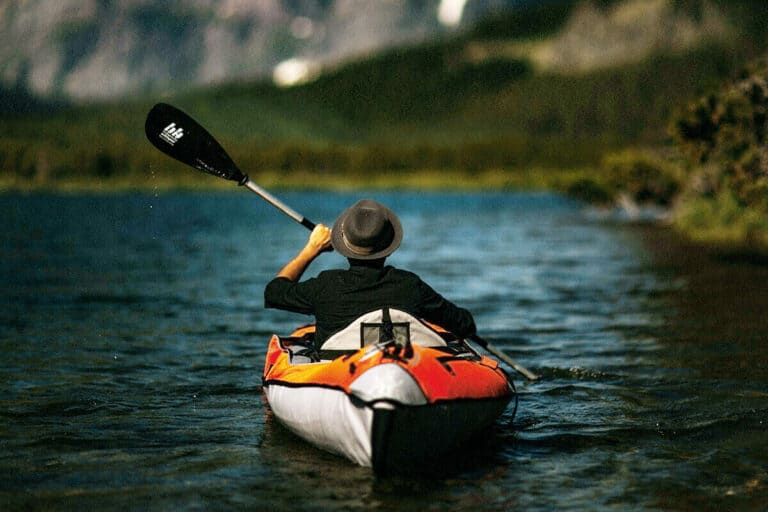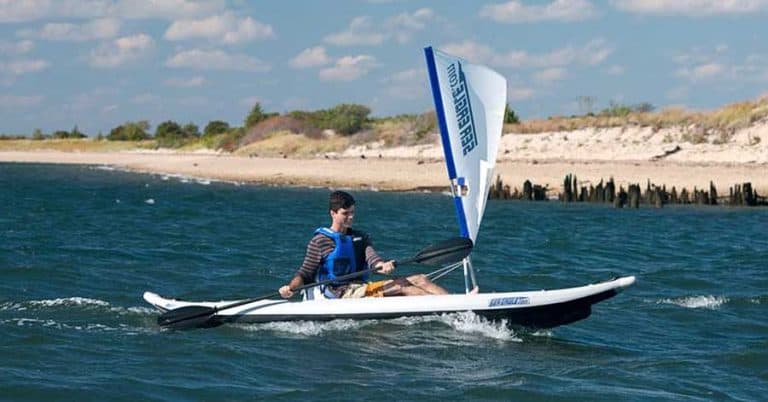Disclosure: I am compensated for purchases made through some links on this site. Click for details.
Proper care of your inflatable kayak will extend the life of your boat for many years. There’s really not much to it. Just follow these simple disassembly, deflation, and storage steps.
Be sure to read the directions for your particular inflatable kayak. If they differ, be sure to follow the manufacturer’s advice.
Your Inflatable Kayak at the Take-Out
The water on which you kayak and your take-out point will greatly influence your process of disassembly, deflation, and storage. Ideally, these tasks would all be done at the take-out but it’s not always possible.
Does your take-out have a flat space that isn’t overly hot to the touch?
Is the surface free of sharp rocks or other debris that could puncture your inflatable kayak?
Taking your kayak off the water at a dock is far different from a muddy creek bank, rocky shore, or sandy beach.
Have an Exit Strategy
It will help to have an exit strategy at take-out. Think about the water you’re kayaking on and plan ahead for the conditions at the end of your trip.
For instance, I often kayak in muddy rivers. If you’ve been in muddy conditions, plan on cleaning off what mud you can in a safe, shallow area of water before taking the kayak out.
When possible, disassemble, clean, and dry off the attached accessories and then hull before deflating and rolling up your inflatable kayak. Doing so will help keep the kayak in good condition and free of mold and mildew.
Whatever your circumstance, do the best you can with the environment of your take-out point and adjust your steps accordingly. It’s not unusual to store your kayak inflated or stow and go with your kayak only to set it up again at home so you can clean, dry, and roll it up appropriately.
Use of a Tarp
Spreading out a tarp is helpful for keeping mud, dirt, sand, grass, and other debris off your wet kayak and its accessories. Tarps can make things easier and lightweight ones don’t take up much room in the kayak either.
If you use a tarp at take-out, keep it folded in half under your kayak until you have cleaned and drained your kayak.
Disassembly and Removal of Gear
- Remove all gear mounted to the sides of your kayak. (i.e. self-leveling cup holder, fishing rod mounts, GoPro camera mount, etc.)
- Remove your paddle and other gear from inside your kayak.
- Detach and remove the seats, thwarts, and any other components attached to the inside of your kayak.
- Detach any removable skegs, rudders, or directional stabilizers that may be attached to a base on the underside of your kayak.
- Clean off and dry your paddle, gear, seats, removable thwarts, skegs, rudders, directional stabilizers, and any other items then set them to the side.
Cleaning, Draining, and Drying Your Inflatable Kayak
Now that your inflatable kayak has been emptied and stripped down to the hull, its time to clean, drain, and dry your kayak.
Don’t deflate your kayak yet. It’s far easier to clean and dry your kayak when it’s inflated.
- If you are placing your kayak on a tarp, keep the tarp folded in half under your kayak until you have cleaned and drained the water out of your kayak. Using a tarp isn’t always necessary, but it can help to avoid cleaning setbacks from dirt and sand.
- Clean dirt and debris off your kayak. An old shirt or towel is useful for this step. Water from the lake, river, or ocean will help in this process. Spray bottles work if you’ve had to move too far from the water’s edge.
- Open the self-bailing plugs and/or drain plugs and drain any water that has splashed inside, fallen off your kayak paddle drip rings, or entered due to cleaning. If your kayak has neither of these, turn it over and dump out any water that’s pooled inside.
- After draining, open up your tarp (if using one) so you have a clean dry surface.
- Close the self-bailing plugs and drain plugs.
- Dry the inside of your kayak with a towel. Then dry the sides. Then flip it over and dry the bottom.
- After drying the bottom, flip the kayak right-side-up so you’ll be ready for deflation.
- If you have some time and the weather is in your favor (nice, sunny, and warm), let your kayak air-dry a little before deflating and folding it up. This will help ensure it’s nice and dry.
Note: The valves should be closed during rinsing or washing. Water that enters the valves does not have a way of escape and will cause internal mold and mildew thus decreasing your boat’s lifespan.
Deflating and Folding Your Inflatable Kayak
- Slowly deflate your kayak, by opening all the valves.
- Gentle pressure can be applied to the sides, floor, and other compartments to speed up deflation.
- Fold the sides of the kayak toward the middle.
- If you have spray skirts at the bow and stern, aline them over the center of the kayak.
- Start folding/rolling up your kayak at the opposite end from the valves. This will help push air out as you fold it up. (Some kayaks have inflations valves in the bow. Some have them in the stern.)
- Somewhat loose folds are often best for preventing damage caused by sharp bends and corners.
- Keep the folds in a shape that will easily fit in your transport bag.
- If you have a skeg base or other stabilizing base, keep it flat within a fold.
- The valves can be closed at the end of the folding process if you’re concerned about debris getting inside.
- If you have any skegs, rudders, or directional stabilizers that remain attached to the kayak, place protectors over them.
Related Content: Inflatable Kayaks: Set Up and Inflation
Packing Your Inflatable Kayak into Its Transport Bag
Finally, place your kayak and its accessories into its transport bag for storage starting with the kayak first then the seats, thwarts, pump, and possibly the paddle or other gear that comfortably fits inside.
At Home Cleanup After a Stow and Go Trip
If it’s inconvenient or impossible to properly clean and dry your inflatable kayak at the take-out, you may have to stow your kayak away as best you can and go on your way.
Follow whatever steps you can from the disassembly, deflation, and storage steps above. Or you may choose to keep it inflated and transport it home on your roof rack.
Once you get home and can re-inflate your kayak and properly take care of it there. Periodic use of inflatable boat cleaner and protectant is needed so having to stow and go isn’t always a disadvantage. You can take care of both processes at once.
Debris and moisture left on inflatable kayaks can cause damage. It’s best if to clean up your kayak within 24 hours. Doing so will improve its longevity.
Storing Your Inflatable Kayak
Store your inflatable kayak in a cool dry place like a basement, attached garage, or closet. Not in your attic or hot garage.
It’s also important to keep it away from any critters that may burrow in or make nests.
Related Content:






